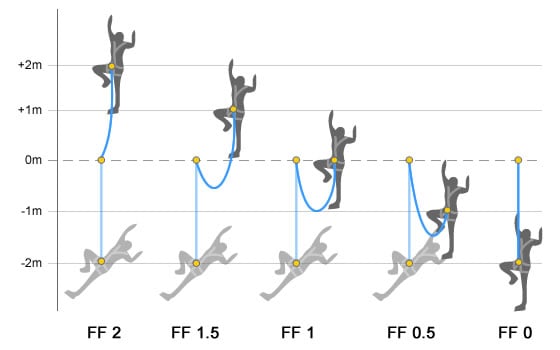Fall Factors in Climbing Ropes
A climbing rope's ability to withstand falls depends largely on its Fall Factor. This metric is useful because it measures the force exerted on a rope in case of a fall. As a result, a high Fall Factor can indicate the rope's ability to survive a fall, but what exactly does it mean? To answer this question, we must take a look at the fall force, and what happens when the factor is high or low.
The Fall Factor – a useful metric for testing rope
One of the most important metrics in choosing a climbing rope is the Fall Factor. This measure measures how much energy a climbing rope can absorb during a fall. The longer the fall, the higher the fall factor. As a rule of thumb, the higher the Fall Factor, the less likely the climbing rope will fail. This test is based on an 80-kilogram weight attached to a 2.6-meter rope. The weight falls repeatedly, creating a 1.77-factor fall. The final fall rating is the number of falls a climbing rope can handle before failure. For climbing ropes that are approved by the UIAA, this number is generally between 1.7 and 1.8.
Fall Force: The force created by a fall will depend on the load and fall factor of the climbing rope. The force will be reduced if the climbing rope can absorb the energy if the fall was a few feet high. A climbing rope with a 0.5 Fall Factor will absorb significantly less energy than a low-stretch rescue rope with the same Fall Factor.
What happens if the fall factor is high?
The fall factor is the ratio of forces generated when a load falls on a climbing rope compared to the length of the rope. A short rope can absorb some of the energy produced by falling, but a long rope can generate high forces. A fall of a meter on a rope of one meter's length will generate massive forces. Similarly, high fall factors tend to happen when the rope is not tensioned or is too close to the anchor. Rescuers are also most likely to experience high fall factors when they approach an edge. The forces are compounded by the weight of the rescuer and the patient.
When the fall factor of a climbing rope is too high, the safety of the climber is compromised. Although the belayer is protected, he still takes tremendous force. In such cases, a short rope is recommended. A climbing rope with a high fall factor should never be used for slabby climbing. This type of climbing is dangerous and may even result in injury. Unless the belayer is very experienced in slabby climbing, the FF of a climbing rope should be 2.0.
What fall factor is used to test ropes?
The fall factor is one of the most confusing things to learn about climbing ropes. It refers to the ratio between the forces generated by falling and the ability of the rope to absorb that force. During a standard climbing rope test, the fall factor is set at 1.71, and the measured forces increase with the fall factor squared. For example, doubling the fall factor would double the forces generated by falling by one-quarter of a foot. However, halving the fall factor would require reducing four factors, and so on.
The fall factor is a very important factor, but it's impossible to determine how strong a climbing rope is until you've fallen from a height and strained it. Luckily, there are tests to determine the fall factor of a climbing rope, which are safe to use in normal conditions and can withstand several light falls. But even if the rope is sturdy enough to survive several light falls, it should be checked regularly before a climbing trip.
Small Examples for Fall Factors
There are several fall factors to consider when choosing a climbing rope. These factors include rope travel, friction with biners, quickdraws, and the length of the rope. The height of the fall and the length of the rope will determine the fall factor. The smaller the fall factor, the more safe the fall will be. However, it is essential to remember that low fall factors are not synonymous with safe falls. Falling can still be dangerous if you don't have a protection system in place.
Fall factors are a key component of climbing safety. Falling less than 0.2 means you will absorb most of the force, and a fall factor of 1.0 indicates a significant amount of force. Fall factors between 1.8 and 1.9 are the norm for climbing rope tests. A fall factor of 1.0 indicates a hard fall that would cause the climber to fall at least three meters. This is also the case when the climber is higher than the belayer.
Falling in the real world
One of the first lessons we learn in high school physics is that things fall at a constant rate. In other words, whether they weigh more or less, feathers and bowling balls will fall at the same rate. The only thing that changes the fall speed is wind resistance, and eventually the two will equalize. This is called terminal velocity, and if we fall faster than that, we will hit the ground and die.
Tips to minimize falling factors
Despite the high levels of fall factors, you can still prevent a falling incident by following some tips. First, avoid tangles. Avoid leaving clips or knots in the rope. Also, avoid climbing in places where the slopes are steep or have other obstructions. Then, make sure to practice your techniques by avoiding fall traps. These tips can help you climb safely without sacrificing your comfort.
When climbing, avoiding a fall will reduce the chances of a falling accident. Falling factors are determined by the amount of force generated by a climber when they fall. The higher the fall factor, the more impact is generated. Avoid using too much rope if possible. Use belay protection frequently. If possible, place protection early on the pitch. A belay that is placed immediately after a fall will prevent a factor two fall.
If you are climbing with a partner, it is a good idea to buy double ropes for each climber. Using double ropes will reduce the drag on both ropes and will help you identify which rope belongs to whom. If one of the ropes breaks, you can always get a backup by using the second rope. If you fall on one rope, you will lose more distance, and more likely to hit something or your partner.
Conclusion:
Typically, a climbing rope will be able to handle several small falls, but what happens when the climber takes a large fall? This article looks at common scenarios to see how much a climbing rope can tolerate. It is important to know how much rope can take before you get on the rock face. A climbing rope that can handle a three-meter fall is considered high-factor. This fall factor is set many times higher than the climber's weight, so any climber's weight could be enough to cause the rope to fail.
Climbing ropes are made of two basic components - the core and the sheath. The core contains the strength and elasticity of the rope. The sheath protects the core from damage. If the core is deformed or damaged, it cannot handle the pressure and impact of the climber. If the sheath is damaged, the rope can't withstand the pressure of the climber or the impact of a fall.


Comments
Post a Comment